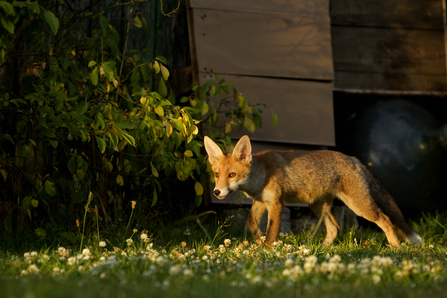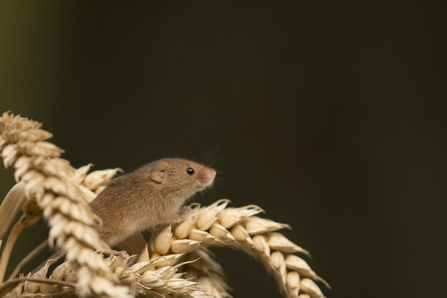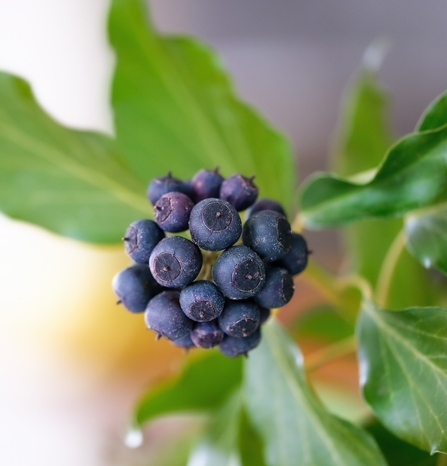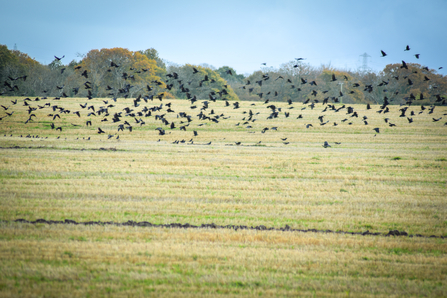
A young red fox exploring a garden at sunset. Picture: Danny Green/ 2020Vision
Arils (yew berries) on a tree in an Oxfordshire churchyard. Picture: Pete Hughes

A young red fox exploring a garden at sunset. Picture: Danny Green/ 2020Vision
While many animals are bedding down for the winter, November is the peak month for male fox dispersal: cubs born in spring are now fully grown and leaving to find their own territory. Dogs go first, followed by vixens. The fox breeding season starts next month, but you might start to hear the first calls now: listen out for barks and howls late into the night.

Bank vole ©Wildstock
Among the mammals that are preparing to spend the winter in hiding are bank voles. These small, furry rodents live in underground burrows and feed on plants. In autumn they stockpile fruits, nuts and seeds to see them through to the spring. Look out for them in meadows like our Iffley Meadows nature reserve in Oxford.

A harvest mouse clambering up an ear of wheat. Picture: Rob Bates
Another rodent to look out for this month is the harvest mouse - indeed, we will be carrying out our annual nest search at our Chimney Meadows reserve in West Oxfordshire in the coming weeks. November is the ideal month to look for these nests because earlier than this the vegetation is still too dense to look, but much later and these fragile bundles - which are the size of a tennis ball - can be destroyed by winter weather. Look for nests suspended in tall tussocky grass around field margins.
Harvest mouse nest by Martha Cowell

Redwing by Jon Hawkins - Surrey Hills Photography
As well as native species, there are also a host of winter visitors to spot this month, including redwings. These attractive birds spend their summers in Scandinavia and flock to the UK to take advantage of the milder winters. If you can't spot them in the hedgerow, listen out for their distinctive 'seep seep' call: you can often hear them passing overhead at night.

Ivy berries
Ivy berries are a superfood and can be found in abundance in November. They don’t rot as quickly as most fruit, so are a useful food late in the year when supplies of other berries have been exhausted. The berries are much loved by birds and before the berries the ivy flowers provide a crucial nectar source late in the year for late-flying insects such as butterflies and ivy bees.

Fly agaric by Roger Stace
As autumn continues, there is an abundance of fungi to look out for. In recent weeks we've seen slimy slippery jacks emerging under pine trees at Snelsmore Common, shaggy parasol mushrooms rising out of the meadows at Moor Copse and beautiful porcelain fungus sprouting out the sides of trees at Warburg Nature Reserve - but the species we've seen more than any is fly agaric. With its iconic red cap and white flecks, it seems to have been a particularly good year for this famous fungus - look out for it at our Snelsmore Common reserve near Newbury.

Arils (yew berries) on a tree in an Oxfordshire churchyard. Picture: Pete Hughes
Another bright red icon to look out for in November is yew arils. These fleshy berries are the only part of the yew tree that isn't toxic, and provide a valuable food source for hundreds of birds, as well as mammals as winter descends. Look out for enormous, ancient yew trees in country churchyards.
Bluetits by Gillian Day
Another avian highlight of this season is the phenomenon of roving tit flocks: as food gets scarce, small songbirds such as blue tits, great tits, goldcrests, and treecreepers gather together in mixed flocks. These groups rove around woodlands together, never staying still in their constant hunt for food. The strategy is thought to provide better foraging results and added safety from predators. Walk through a quiet woodland like our Whitecross Green Wood nature reserve near Bicester and you might be lucky enough to stumble on one of these marauding gangs.

A flock of rooks taking flight from a field in autumn. Picture: Flying400/ Wikimedia Commons
Rooks and jackdaws also start to form large groups at this time of year which can offer similar benefits. Rooks in particular can gather in fields in enormous flocks comprised of tens of thousands of birds. As the sun sets these huge groups will take flight, shrieking as they do so, and fly to their nocturnal roosting sites.

Starling murmuration by David Tipling/2020VISION
However the undisputed champions of phenomenal flocking are the starlings. As November arrives, these attractive birds, with their iridescent feathers, start to perform their world-famous murmurations. These clouds of birds can contain hundreds of thousands of individuals, and one of the best places to see the spectacle in this area is our Thatcham Reedbeds reserve next door to our Nature Discovery Centre near Newbury, just as the sun starts to set. See you there!
Sign up below to receive the latest news from BBOWT, tips about how you can help wildlife, plus information on how you can get involved.